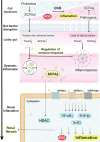Gut microbiota regulates oxidative stress and inflammation: a double-edged sword in renal fibrosis
- PMID: 39636415
- PMCID: PMC11621299
- DOI: 10.1007/s00018-024-05532-5
Gut microbiota regulates oxidative stress and inflammation: a double-edged sword in renal fibrosis
Abstract
Gut microbiota is a complex and dynamic system that plays critical roles in human health and various disease. Progressive chronic kidney disease (CKD) suggests that patients irreversibly progress to end-stage kidney disease and need renal replacement treatments, including dialysis and transplantation. Ample evidence indicates that local oxidative stress and inflammation play pivotal roles in the pathogenesis and progression of CKD and dysbiosis of gut microbiota. CKD is always accompanied by intestinal inflammation and oxidative stress, which lead to rapid systemic translocation of bacterial-derived uraemic toxins, including indoxyl sulphate, phenyl sulphate and indole-3-acetic acid, and the consequent development and aggravation of renal fibrosis. Although inflammation and oxidative stress have been extensively discussed, there is a paucity of reports on the effects of gut microbiota on renal fibrosis and gut microbiota mediation of oxidative stress and inflammation. This review provides an overview of gut microbiota on inflammation and oxidative stress in renal fibrosis, briefly discusses regulation of the gut flora using microecological preparations and natural products, such as resveratrol, curcumin and emodin as treatments for CKD, and provides a clear pathophysiological rationale for the design of promising therapeutic strategies.
Keywords: Chronic kidney disease; Gut-kidney axis; Inflammation; Microecological preparations; Natural products; Oxidative stress.
© 2024. The Author(s).
Conflict of interest statement
Declarations. Conflict of interests: The authors have no relevant financial or non-financial interests to disclose. The authors report no declarations of interest. Ethical approval: Not applicable. Consent to participate: Not applicable. Consent to publish: Not applicable.
Figures




Similar articles
-
The Impact of CKD on Uremic Toxins and Gut Microbiota.Toxins (Basel). 2021 Mar 31;13(4):252. doi: 10.3390/toxins13040252. Toxins (Basel). 2021. PMID: 33807343 Free PMC article. Review.
-
The gut-kidney-heart axis in chronic kidney disease.Physiol Int. 2019 Sep 1;106(3):195-206. doi: 10.1556/2060.106.2019.19. Epub 2019 Sep 27. Physiol Int. 2019. PMID: 31560235 Review.
-
Curcumin modulated gut microbiota and alleviated renal fibrosis in 5/6 nephrectomy-induced chronic kidney disease rats.PLoS One. 2025 Jan 9;20(1):e0314029. doi: 10.1371/journal.pone.0314029. eCollection 2025. PLoS One. 2025. PMID: 39787157 Free PMC article.
-
Gut microbiome in chronic kidney disease.Exp Physiol. 2016 Apr;101(4):471-7. doi: 10.1113/EP085283. Epub 2015 Oct 2. Exp Physiol. 2016. PMID: 26337794 Review.
-
POTENTIAL THERAPEUTIC OPTIONS TARGETING THE GUT DYSBIOSIS IN CHRONIC KIDNEY DISEASE.Wiad Lek. 2022;75(7):1757-1764. doi: 10.36740/WLek202207127. Wiad Lek. 2022. PMID: 35962694
Cited by
-
Fecal microbiota transplantation is a promising therapy for kidney diseases.Front Med (Lausanne). 2025 Jul 9;12:1628722. doi: 10.3389/fmed.2025.1628722. eCollection 2025. Front Med (Lausanne). 2025. PMID: 40703302 Free PMC article. Review.
-
Associations Between Uraemic Toxins and Gut Microbiota in Adults Initiating Peritoneal Dialysis.Toxins (Basel). 2025 Jul 1;17(7):334. doi: 10.3390/toxins17070334. Toxins (Basel). 2025. PMID: 40711145 Free PMC article.
-
Acteoside-containing caffeic acid is bioactive functional group of antifibrotic effect by suppressing inflammation via inhibiting AHR nuclear translocation in chronic kidney disease.Acta Pharmacol Sin. 2025 Jun 20. doi: 10.1038/s41401-025-01598-4. Online ahead of print. Acta Pharmacol Sin. 2025. PMID: 40542283
-
Faecal Microbiota Transplantation as an Adjuvant Treatment for Extraintestinal Disorders: Translating Insights from Human Medicine to Veterinary Practice.Vet Sci. 2025 Jun 3;12(6):541. doi: 10.3390/vetsci12060541. Vet Sci. 2025. PMID: 40559778 Free PMC article. Review.
-
Application of SGLT-2 inhibitors in non-diabetic CKD: mechanisms, efficacy, and safety.Front Med (Lausanne). 2025 Jul 1;12:1574693. doi: 10.3389/fmed.2025.1574693. eCollection 2025. Front Med (Lausanne). 2025. PMID: 40665981 Free PMC article. Review.
References
-
- Matsushita K, Ballew SH, Wang AY, Kalyesubula R, Schaeffner E, Agarwal R (2022) Epidemiology and risk of cardiovascular disease in populations with chronic kidney disease. Nat Rev Nephrol 18:696–707 - PubMed
-
- Rashid I, Katravath P, Tiwari P, D’Cruz S, Jaswal S, Sahu G (2022) Hyperuricemia—a serious complication among patients with chronic kidney disease: a systematic review and meta-analysis. Explor Med 3:249–259
-
- Humphreys BD (2018) Mechanisms of renal fibrosis. Annu Rev Physiol 80:309–326 - PubMed
Publication types
MeSH terms
Grants and funding
LinkOut - more resources
Full Text Sources
Medical

